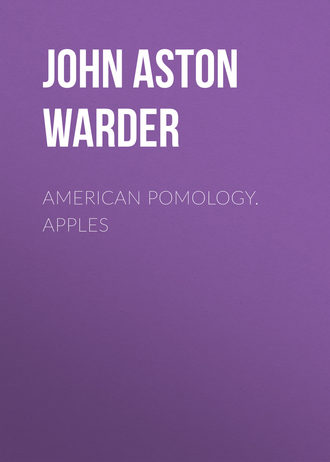 полная версия
полная версияПолная версия
American Pomology. Apples
Tree thrifty, healthy, early productive, round-headed, twiggy; Shoots medium or slender, reddish brown, leaves large.
Fruit large to very large, regular, globular-conic; Surface generally smooth, yellow-green, nearly covered with mixed red, striped and splashed scarlet; Dots minute, scattered.
Basin regular, abrupt; Eye small, closed; Calyx long.
Cavity wide, folded, brown; Stem short.
Core wide, large, irregular, open, meeting or slightly clasping the eye; Seeds numerous, short, plump, pale; Flesh whitish, breaking, granular, juicy; Flavor sour, not rich; Quality good, only for its special uses, market, cooking and drying; Season, October to December.
Clarke's Pearmain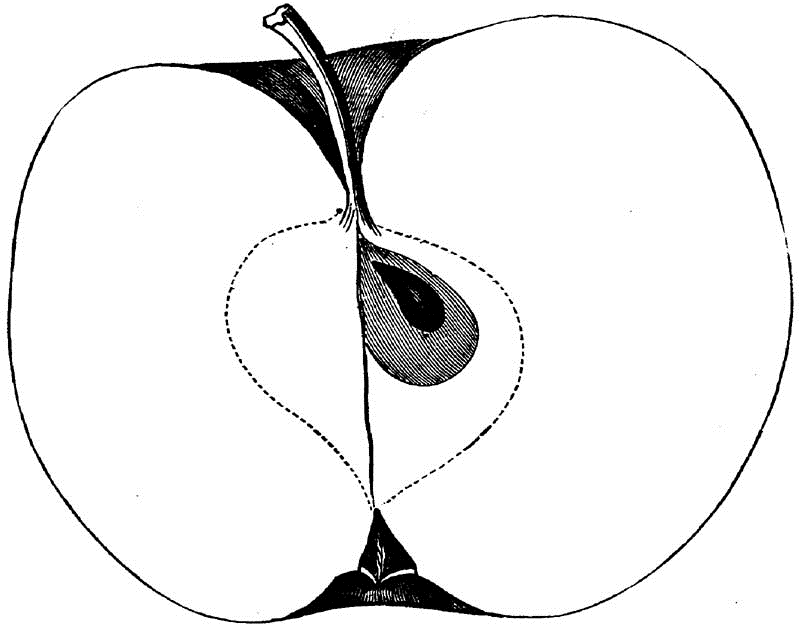
Fig. 152.—CLARKE'S PEARMAIN.
Origin North Carolina. Specimens from W.S. Westbrook. Tree grows slowly, but very productive.
Fruit medium, roundish-conic, truncated; Surface yellow, covered bright red and bronzed; Dots numerous, large, yellow.
Basin abrupt, folded; Eye small, closed; Segments short, reflexed.
Cavity deep, acute, sometimes lipped; Stem long, red.
Core small, pyriform, regular, closed, scarcely clasping; Seeds, some imperfect; Flesh greenish-yellow, fine grained; Flavor sub-acid, rich; Quality good to very good; Use dessert and kitchen; Season December.
Clayton
Fig. 153.—CLAYTON.
Believed to have originated in Central Indiana. Brought to my notice by Z.S. Ragan, of Clayton, Indiana; also exhibited by the Plainfield Horticultural Society at the meetings of the State Horticultural Society.
Fruit large, conical, flattened, regular; Surface smooth, greenish-yellow, covered with dull red, striped and splashed darker; Dots minute, scattered.
Basin narrow, abrupt, regular; Eye small, long, closed.
Cavity wide, acute, deep, wavy, green; Stem medium, stout.
Core wide, regular, open, clasping; Seeds numerous, plump, angular, short, dark; Flesh yellow, breaking, not fine grained; Flavor sub-acid; Quality good; Use, kitchen and market; Season, all winter until March.
Cooper's MarketCOOPER'S REDLING"Fruit medium, oblong-conic; Skin yellowish, shaded with red, and striped with crimson; Stem short, cavity deep, narrow; Calyx closed, basin small; Flesh white, tender, with a brisk sub-acid flavor; December to May."—(Downing.)
Early JoeThis delicious summer apple originated in Ontario County, New York; Tree moderately vigorous, bushy when young, early bearer, very productive.
Fruit small to medium, flat-conic, regular; Surface yellow or waxen, mixed red, splashed carmine; Dots minute, with yellow bases.
Basin abrupt, regular; Eye medium, long, closed; Segments reflexed.
Cavity wide, acute, wavy, green; Stem medium, thick.
Core wide, closed, clasping; Seeds plump, brown; Flesh light yellow, breaking, very fine grained, juicy; Flavor sub-acid, aromatic, spicy, rich, very satisfying; Quality best; Use, dessert only; Season, July.
Early StrawberryAMERICAN RED JUNEATING
Fig. 154.—EARLY STRAWBERRY.
Origin New York; Tree thrifty, very upright, while young, spreading and large when older; Shoots dark colored; Foliage abundant on long stems, bright green, almost shining, rather narrow, long, erect.
Fruit small to medium, round-conic, regular or rarely angular; Surface smooth, often shining, yellow, mostly covered with mixed red, striped crimson; Dots rare, very minute; Surface sticky or "greasy" when house-ripened.
Basin shallow, folded or plaited; Eye medium, long; Segments reflexed.
Cavity medium, regular; Stem long, rather slender, sometimes short, knobby.
Core regular, closed, not meeting the eye; Seeds numerous, broad, plump; Flesh whitish-yellow, breaking, fine grained, juicy; Flavor sub-acid, aromatic; Quality good to very good; Use, dessert, market; Season, July and August.
FamilyThis new southern variety is not yet sufficiently known to enable me to give a full description. My trees have not borne.
Fruit medium, conic, striped red; Season, July and August.
Flushing SpitzenbergAs some doubt has existed in the minds of many pomologists in respect to this variety, and as many have had this name applied to the Baltimore of Elliott, I quote that author's description:
"American. Tree vigorous, strong brown shoots; Fruit medium, roundish, slightly conical, greenish-yellow, mostly covered with warm yellowish-red; russet dots, with suffused fawn shade surrounding; Stem slender; Cavity narrow; Calyx small; Basin shallow; Core rather large; Flesh white, tinged yellow, juicy, crisp, mild, nearly sweet; 'very good.'" November to February.
GabrielLADIES' BLUSH.—GARDEN OF INDIANAThis is thought to be a southern apple, but the origin is unknown. It may yet prove to be a known variety in cultivation.
Tree moderately vigorous, productive.
Fruit medium, conic, regular; Surface smooth, greenish-yellow, mixed and striped pale red; Dots minute.
Basin medium, regular; Eye medium, closed.
Cavity regular, green; Stem medium, slender.
Core regular, closed; Seeds medium; Flesh tender, fine grained, juicy; Flavor sub-acid to sweet, aromatic; Quality almost best, for dessert; August and September, or later.
Limbertwig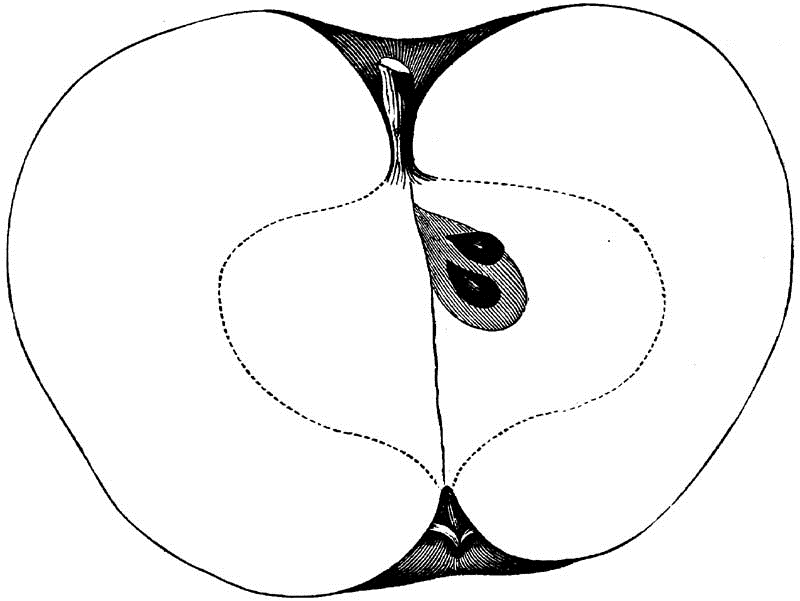
Fig. 155.—LIMBERTWIG.
This well known southern apple is much cultivated in many parts of the West as a long keeping winter variety. It is a favorite with the southern immigrants, and found most abundant in regions occupied by them, but it has been carried pretty far to the north. The synonym James River, as given by Downing, is not met with among the people as applied to this apple, but the Willow Twig is often so named.
Tree thrifty, exceedingly productive; Shoots slender and drooping with the heavy crops.
Fruit medium to small, roundish conic, regular; Surface rather smooth, mixed dull purplish red, on green, stripes scarcely to be traced; Dots numerous, large, irregular, brown.
Basin medium, regular; Eye small, open.
Cavity deep, acute, brown; Stem medium, curved.
Core rather large, regular, turbinate, closed, clasping; Seeds numerous, small, plump, long; Flesh greenish-yellow, firm; Flavor sub-acid, rich, aromatic; Quality very good; Use, table and kitchen; Season, March and April. Keeps very well, but wilts if exposed to the air—preserved very well in the ground.
Long Island Seek-no-FurtherWESTCHESTER SEEK-NO-FURTHERThis old variety still has its admirers in the Eastern States, but is not often seen in the West. I describe specimens from Wm. S. Carpenter, of Westchester County, New York.
The tree is vigorous and productive.
Fruit rather large, oblate, conic, regular; Surface greenish-yellow, splashed bright red; Dots numerous, scattered, russet.
Basin shallow, wavy; Eye medium, closed.
Cavity wide, regular, brown; Stem long.
Core regular, closed; Seeds pointed, angular, imperfect; Flesh greenish-white, breaking, juicy; Flavor sub-acid, aromatic; Quality good to very good; Use, table, cooking; Season, October, November.
Polly BrightOrigin Virginia. Considerably cultivated in Eastern Ohio.
"Fruit elongated, conic; Skin light yellow, shaded carmine, obscurely striped; Stalk of medium length, in an acute cavity, russeted; Calyx in a small furrowed basin. Flesh tender, juicy, with a pleasant sub-acid flavor; September, October."—(Downing.)
Rawle's JanetJANETTING OR GENETON—NEVER FAIL—ROCK RIMMON, ETC., ETC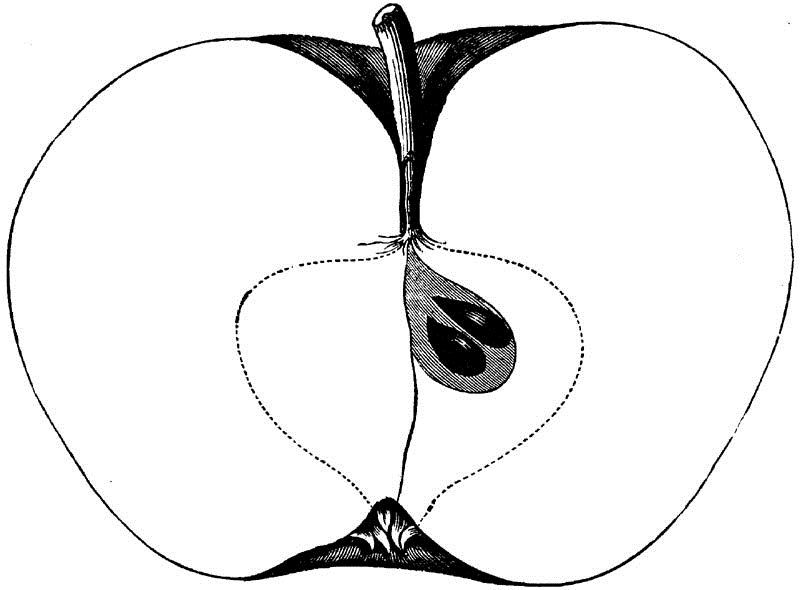
Fig. 156.—RAWLE'S JANET.
This famous southern apple has been spread throughout the West, and even the Northwest where, however, it has not proved hardy. It also has the fault of over-bearing, when the fruit is often small and insipid. In suitable soils it is very fine and deservedly a favorite with planters, some of whom recommend fifty trees of this variety in an orchard of one hundred. Origin Virginia.
Tree thrifty, not large, spreading; Twigs brownish, foliage medium, rather whitish. Blossoms appear later than other sorts, and thus they sometimes escape a spring frost.
Fruit medium, sometimes large when thinned, flattened, conic, regular; Surface smooth, mixed and striped crimson on yellow and green; Dots numerous, small.
Basin wide, regular; Eye small, closed; Segments reflexed.
Cavity acute, deep, regular, brown; Stem long, curved.
Core regular, heart-shaped, closed, clasping; Seeds numerous, plump; Flesh yellowish, crisp, breaking, fine grained, juicy; Flavor sub-acid, vinous, refreshing; Quality good to very good; Use, dessert, kitchen, market and cider; Season, February, March, and later.
Red Winter PearmainRED GILLIFLOWER—RED LADY FINGER—BUNCOMBE? ETCThis favorite southern apple is widely diffused through the South and West, and its good qualities have made it many admirers. Origin uncertain.
Tree sufficiently vigorous, upright, productive, annual bearer.
Fruit medium to large, conic, regular; Surface smooth, deep red, almost purplish on yellow, stripes nearly lost in the depth of coloring, whitish shading exteriorly, not a bloom; Dots numerous, minute.
Basin regular, plaited or folded; Eye long or large, open.
Cavity acute, regular, green; Stem medium length, thick, knobby.
Core medium, closed, clasping; Seeds numerous, large, plump; Flesh yellow, breaking, juicy; Flavor mild sub-acid, almost sweet, rich, satisfying; Quality good; Use, table and kitchen; Season, December and January.
Rosy Red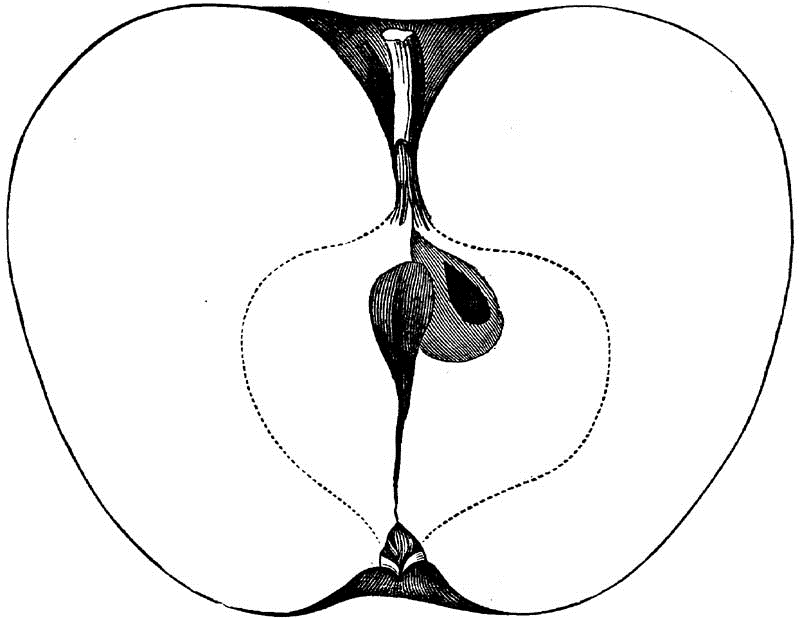
Fig. 157.—ROSY RED.
This is one of the valuable fruits which we owe to the indefatigable efforts, of that earnest pomologist and thus philanthropist, Lewis Jones, of Cambridge, Indiana. Found in a seedling orchard.
Fruit medium, conical, truncated, regular; Surface smooth, bright red, generally diffused, indistinctly striped; Dots scattered, medium, yellow.
Basin medium, shallow, regular or folded; Eye medium, closed.
Cavity acute, narrow, deep, brown; Stem medium, slender, yellow.
Core wide, indistinct, partly open, scarcely meeting the eye; Seeds few, plump and imperfect; Flesh pale yellow, breaking, juicy; Flavor sub-acid; Quality good; Use, market and table; Season, December and January.
Westfield Seek-no-Further
Fig. 158.—WESTFIELD SEEK-NO-FURTHER.
This favorite Connecticut apple has been widely disseminated throughout the country, and is universally admired by those who come from the Northern States; on lower parallels it is less known, and not so highly appreciated, nor is it so fine a fruit, being larger, but less compact, more spongy, less beautifully colored and sometimes almost a russet.
Tree vigorous, thrifty, spreading, productive.
Fruit medium, roundish-conic; Surface smooth dull red, mixed and striped on yellow, in the North clear bright red; Dots scattered, large, yellow; leather-cracked and russeted about the apex.
Basin shallow, regular, leather-cracked; Eye small, closed or open.
Cavity pointed, regular, brown; Stem long.
Core medium, regular, closed, meeting and clasping the eye; Seeds numerous, small, pointed; Flesh yellowish-white, tender, breaking; Flavor very mild sub-acid, aromatic, satisfying, not high flavored nor spicy; Quality only good in my estimation; Use, table and market; Season, December.
CLASS II.—CONICAL APPLESORDER I.—REGULARSECTION 2.—SOURSUB-SECTION 3.—RUSSETAmerican Golden RussetBULLOCK'S PIPPIN, ETC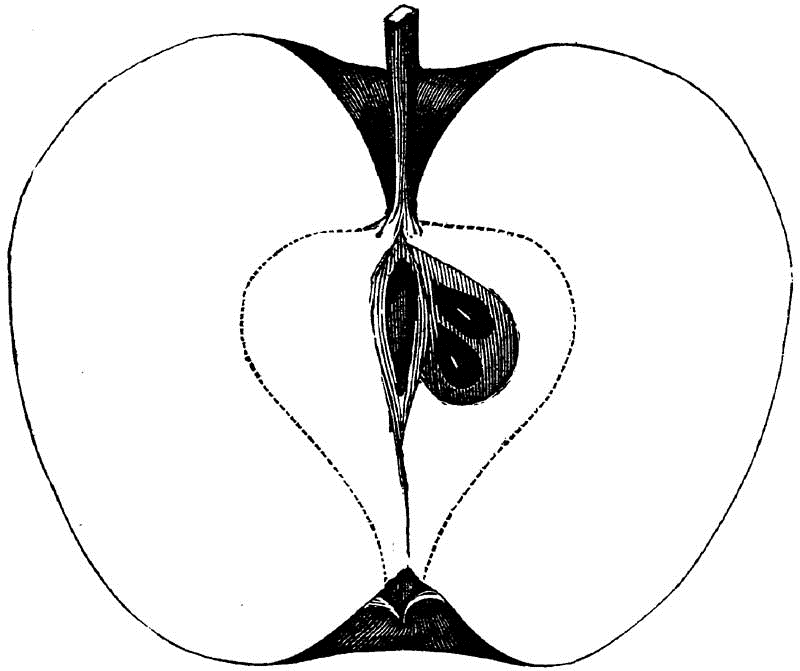
Fig. 159.—AMERICAN GOLDEN RUSSET.
This delicious table apple is a universal favorite with all who can appreciate delicacy of flavor and fineness of flesh in an apple, and yet it is not a profitable variety for orchard planting, because the fruit is very apt to be imperfect. The best I have seen were from the South, and sandstone soils.
Tree vigorous, upright, round-headed, small; Foliage large, healthy.
Fruit small to medium, round-conic, regular when perfect; Surface smooth, yellow, covered with thin russet, sometimes faintly blushed; Dots minute.
Basin shallow, regular; Eye small, closed.
Cavity acute, regular; Stem long, slender.
Core medium, closed, meeting the eye; Seeds numerous, pointed; Flesh yellowish, very fine grained, tender, when fully ripe almost melting, like a pear, juicy, becoming dry when over ripe; Flavor sub-acid, rich, aromatic; Quality very best; Use, dessert; Season, November and December.
CheesboroughThis is one of the largest and one of the poorest of the Russet apples, and unworthy of cultivation; on that account put upon record to be avoided.
Fruit large and fair, conical, regular; Surface dull green, overspread with thin russet, or more southward.
Basin irregular, green; Eye large, closed.
Cavity pointed, regular; Stem short.
Core large, closed, clasping; Seeds long, pointed, angular; Flesh green, breaking, coarse, often dry; Flavor acid or sub-acid, not rich; Quality poor; Use, kitchen only; Season, November and December.
Egyptian RussetBAGBY RUSSET
Fig. 160.—EGYPTIAN RUSSET.
This capital dessert fruit was found in Southern Illinois and introduced to his fellow pomologists of the State Society by Jno. M. Hunter, nurseryman, of Ashley. Its origin is unknown, but supposed, like the pioneers of the region, to have come from Tennessee, or some other Southern State.
Tree symmetrical, moderately vigorous, productive; Twigs slender.
Fruit medium, regular, conical, truncated; Surface smooth, light yellow, covered with fine russet, obscurely striped gray.
Basin wide, wavy, plaited, green; Eye medium to large, open.
Cavity acute, wavy; Stem medium.
Core irregular, closed, scarcely meeting the eye; Seeds large, plump; Flesh very tender, fine grained, juicy; Flavor sub-acid, aromatic, rich, pear-like; Quality very best; Use, dessert; Season, December and January, until March. Like other russets disposed to wilt if too much exposed to the air.
Poughkeepsie RussetENGLISH RUSSET
Fig. 161.—POUGHKEEPSIE RUSSET.
Origin New York; Tree tender, vigorous, upright, productive; Shoots brown, slender; Foliage healthy.
Fruit medium, conical or globular-conical, regular; Surface smooth, almost polished, dull yellowish-green, often bronzed near the base, more or less covered with fine russet.
Basin shallow, regular; Eye large, closed.
Cavity pointed, wavy; Stem long.
Core closed, not meeting the eye; Seeds imperfect; Flesh greenish, firm, inclined to be tough; Flavor acid, poor; Quality third rate; Use, market and cooking only, and valued because it keeps soundly for a long time; Season, December until June.
Ross' NonpareilSPICE RUSSET? OF OHIO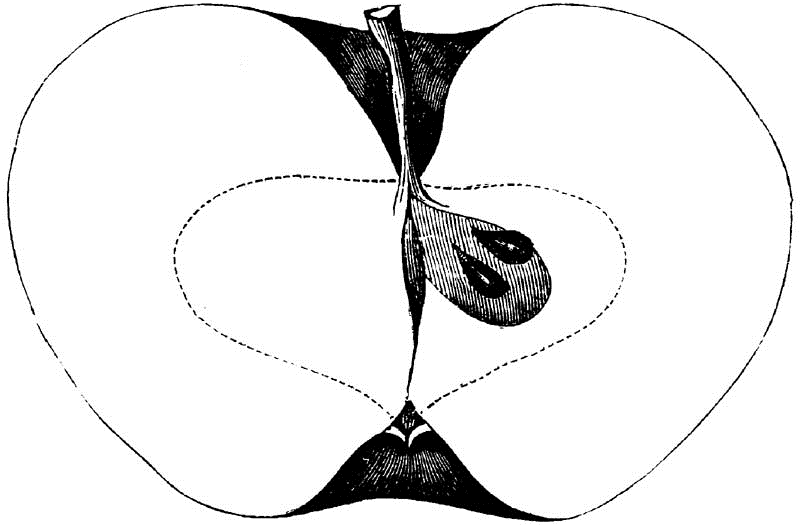
Fig. 162.—ROSS' NONPAREIL.
The delicious fruit about to be described is believed to be the celebrated Irish apple mentioned by Thompson, Lindley, and others; if not, we have found another choice fruit, which deserves to be better known. It is frequently found at the exhibitions in Ohio and Indiana. Often shown as Spice Russet, flatter and irregular: Vide conspectus.
Fruit medium, regular, oblate-conical; Surface smooth, yellowish, thin russet, rarely blushed dull carmine; Dots minute, gray.
Basin wide, folded; Eye medium, closed.
Cavity deep, acute, wavy; Stem long, inclined.
Core regular, open, scarcely meeting the eye; Axis short; Seeds numerous, medium, plump; Flesh white, breaking, fine grained, tender; Flavor sub-acid, aromatic, rich; Quality almost best; for table; Season December.
Spafford Russet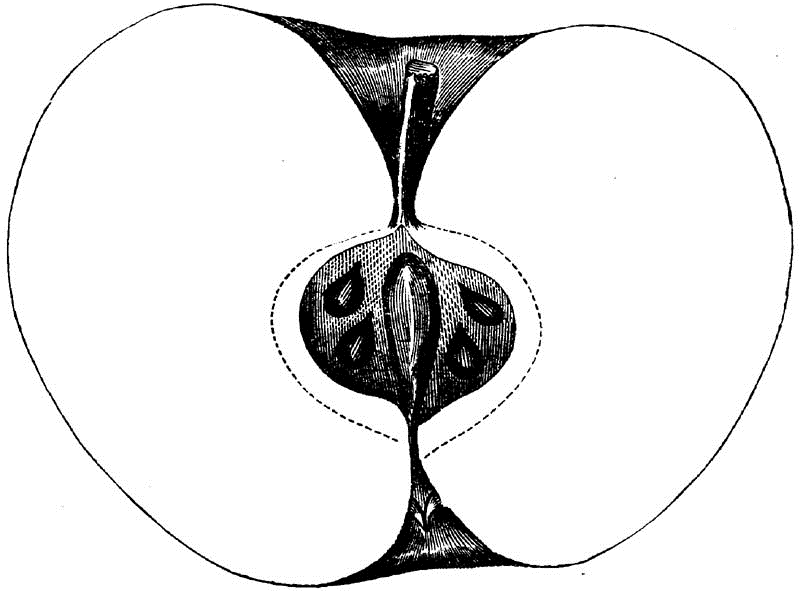
Fig. 163.—SPAFFORD RUSSET.
This apple is supposed to have originated near old Fort Miami, in Northern Ohio, and was introduced to the notice of the Ohio Pomological Society by its Vice-President, J. Austin Scott, of Toledo, who cultivates the variety on the banks of the Maumee, near the place of its supposed origin.
Fruit medium, flattened-conical, regular; Surface smooth, greenish-yellow, lightly russeted, rarely bronzed; Dots minute, green.
Basin medium, abrupt, narrow, regular; Eye small, closed.
Cavity wide, wavy, green; Stem medium.
Core small, open, regular, meeting the eye; Axis short. Seeds numerous, plump, angular; Flesh white, fine grained, juicy; Flavor sub-acid, rich, aromatic, agreeable; Quality good to very good; Use, table; Season, December until March.
CLASS II.—CONICAL APPLESORDER II.—IRREGULAR OR ANGULARSECTION 1.—SWEETSUB-SECTION 1.—SELF-COLOREDBelden Sweet"Grown in Connecticut, very prolific; Fruit medium or below, conic, angular; Skin light yellow, with a warm cheek. Stem medium, in an acute deep cavity; Calyx closed, in a small basin; Flesh white, tender, juicy, saccharine, with a pleasant aromatic flavor; December to March."—(Downing.)
Lyman's Pumpkin SweetPOUND SWEETOrigin, the orchard of S. Lyman, Manchester, Connecticut. A very handsome, large, sweet apple, valued for baking and for stock-feeding.
Tree vigorous, spreading, drooping, rather productive.
Fruit large to very large, roundish-conical, angular; Surface very smooth, pale yellow; Dots minute.
Basin deep, abrupt, regular; Eye medium, closed.
Cavity deep, acute, regular, brown; Stem medium or short.
Core large, closed; Seeds angular, dark; Flesh yellowish, breaking, juicy, often water-cored and heavy; Flavor very sweet; Quality good; Use, baking and stock-feeding; Season, October to December.
CLASS II.—CONICAL APPLESORDER II.—IRREGULARSECTION 1.—SWEETSUB-SECTION 2.—STRIPEDNoneCLASS II.—CONICAL APPLESORDER II.—IRREGULARSECTION 1.—SWEETSUB-SECTION 3.—RUSSET Sweet Russet of Kentucky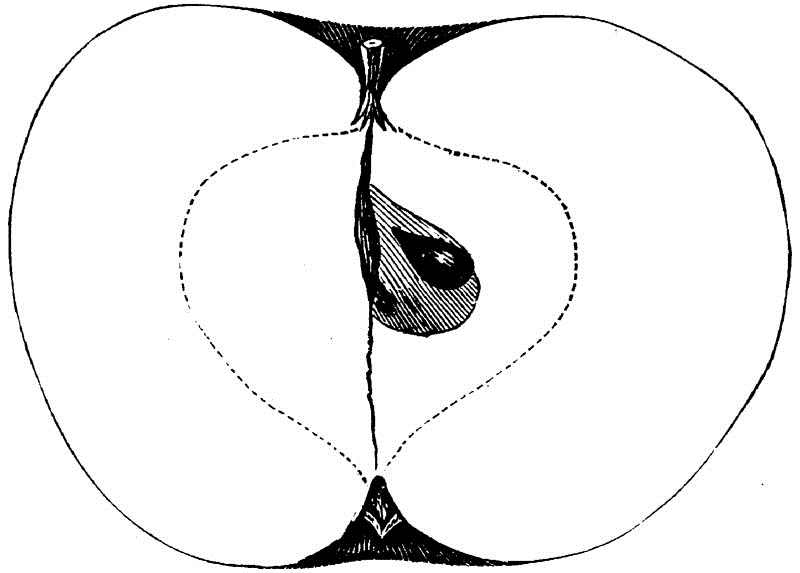
Fig. 164.—SWEET RUSSET OF KENTUCKY.
This fruit was received from J.S. Downer & Son, Elkton, Kentucky.
Fruit small, conical, truncated, angular; Surface rough, dark russet; Dots scattered, minute, white, prominent.
Basin shallow, regular; Eye small, closed.
Cavity very shallow, acute; Stem short, slender.
Core large, regular, nearly closed, meeting the eye; Seeds numerous, angular, pale; Flesh yellowish-white, fine-grained, not tender; Flavor sweet; Quality scarcely good; Season, December to February.
Sweet Russet
Fig. 165.—SWEET RUSSET.
Fruit medium, conical, uneven; Surface yellow, thin russet; Dots numerous, small, prominent.
Basin shallow, folded; Eye small, closed.
Cavity wide, wavy; Stem short.
Core oval, open, clasping the eye; Seeds plump; Flesh yellow, tender, fine grained, juicy; Flavor sweet; Quality good to very good; Use, baking; Season, August.
S.B. Parsons of Flushing, Long Island, considers it the best baking apple.
CLASS II.—CONICAL APPLESORDER II.—IRREGULARSECTION 2.—SOURSUB-SECTION 1.—SELF-COLORED OR BLUSHEDBelmontGATE—MAMMA BEAN, ETC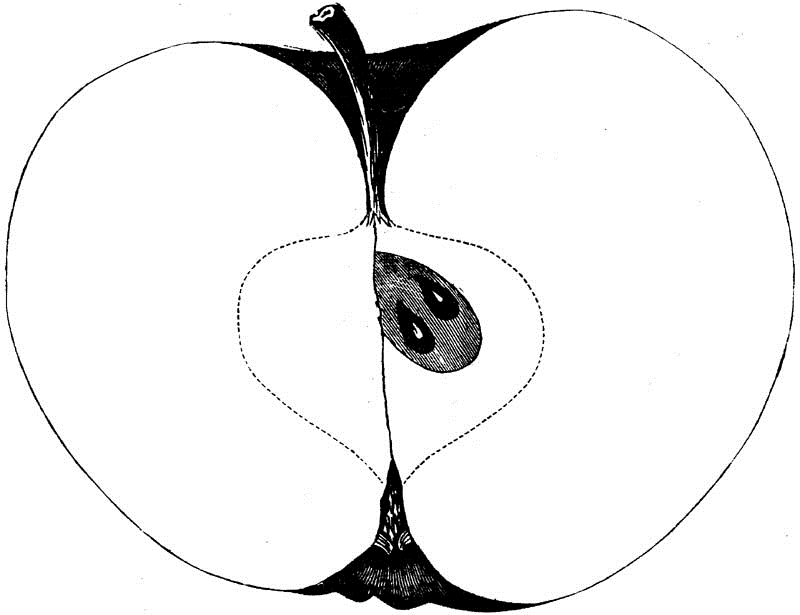
Fig. 166.—BELMONT.
This beautiful apple is believed to be of Virginia origin, but was brought into public notice and notoriety in Belmont County, Ohio, whence its name. It is supposed to be the same as the Waxen of Coxe, which that author refers to Virginia.
Tree vigorous, spreading, productive, not hardy; Twigs light olive.
Fruit large, fair, oblate-conic, often angular; Surface very smooth, waxen-yellow, often faintly blushed orange, and spotted red; Dots minute, scattered.
Basin regular or wavy, not deep; Eye small, closed.
Cavity wide, wavy, brown; Stem long.
Core wide, regular, somewhat open, clasping; Axis short; Seeds numerous, large, flat; Flesh yellow, tender, fine-grained, juicy; Flavor mild sub-acid, refreshing, very agreeable; Quality nearly best; Use, table, kitchen, market; Season, October to December.
Celestia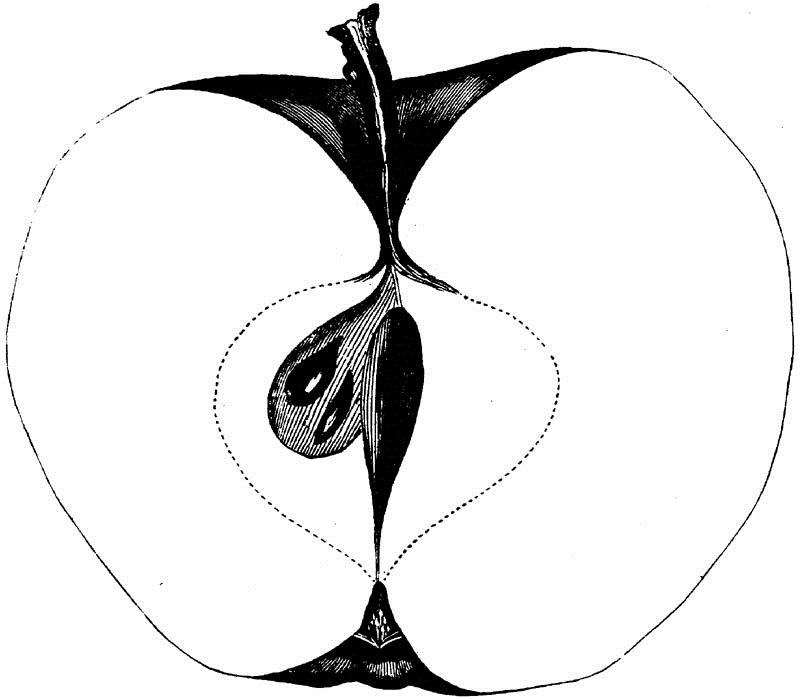
Fig. 167.—CELESTIA.
This fine amateur fruit, which appears destined to take the place of the Dyer, being more handsome, is a seedling from the Stillwater Sweet, and was produced by L.S. Mote, of Miami County, Ohio.
Fruit large, conical, truncated, angular; Surface somewhat uneven, smooth, waxen-yellow; Dots scattered, distinct, gray, with green bases.
Basin narrow, folded; Eye small, long, closed.
Cavity wide, shallow, angular; Stem long or medium, sometimes knobby.
Core small, oval, open, clasping; Seeds numerous, long, angular; Flesh yellow, very fine grained, very tender, juicy; Flavor sub-acid, very sprightly, and spicy, aromatic; Quality very best; Use, table and kitchen; Season, September.
This is essentially an amateur's fruit, as its texture and color disqualify it for market, while its delicious flavor renders it very attractive.
Detroit BlackDETROIT RED?—GRAND SACHEM
Fig. 168.—DETROIT BLACK.
Supposed to be of Canadian origin, in the neighborhood of Detroit, Michigan. I have put these two names together, because the fruits presented as Black and as Red Detroit are so very much alike in all respects that it is not worth while to consider them distinct.
Fruit large to very large, conic, angular; Surface very smooth, shining, deep red shaded, almost black in some specimens, no striping; Dots, numerous, minute, indented, gray.
Basin deep, abrupt, folded; Eye small, open.
Cavity wide, wavy; stem very short.
Core wide, closed or open, clasping the eye; Seeds numerous, angular, brown; Flesh whitish, tender, breaking, juicy; Flavor acid, poor; Quality second to third rate; Use, kitchen and drying; Season, September and October.
The Red variety may be distinct, as it keeps later.
Fall Geneting
Fig. 169.—FALL GENETING.
Elliott says this is an old Connecticut variety. Tree vigorous and productive.
Fruit large, flattened-conic, angular; Surface smooth, greenish-yellow, blushed; Dots rare, minute.
Basin shallow, plaited; Eye small, closed; Calyx reflexed.
Cavity deep, wide, regular, brown; Stem short.
Core small, regular, closed, clasping; Seeds numerous, plump or imperfect, brown; Flesh yellow, fine grained, juicy, crisp; Flavor sub-acid, not very rich; Quality good; Use, table, kitchen; Season, October.
FerdinandI procured my trees from Virginia, where it originated. Tree vigorous, upright.
Fruit large, flattened-conic, irregular; Surface smooth, pale green or yellow.
Basin shallow; Eye medium, open.
Cavity medium; Stem stout.
Flesh yellow, tender; Flavor sub-acid; Quality good; Season, "November to March," according to Mr. Summer, South Carolina.
Harrison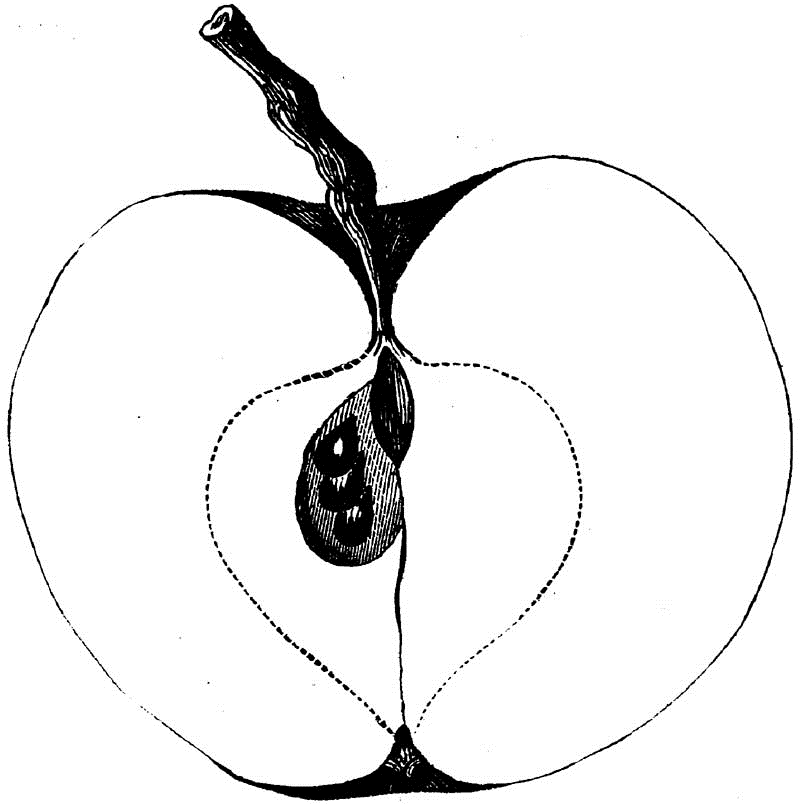
Fig. 170.—HARRISON.
This famous Jersey cider apple, from Essex County in that State, has been carried westward over a great extent of territory, where it succeeds admirably well, and where the necessities of the people have brought to light its good properties for the kitchen as well as for the cider mill.



